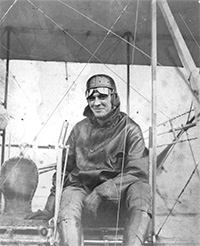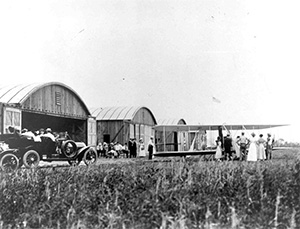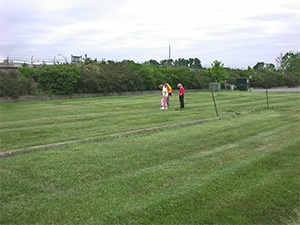 |
||

College Park, just seven miles north of Washington, DC, is the world’s oldest continuously operated airport. In 1909, after trials at Ft. Myer, Virginia, the U.S. Army agreed to buy a flying machine from the Wrights. To fulfill the contract, Wilbur was required to train two officers “of reasonable intelligence to become proficient in its use in a reasonable amount of time.” The commanding officer at Ft. Myer, however, was concerned that the operation of the machine and the large crowds it attracted were interfering with the training of cavalry horses and insisted that another location be found. A large, level field near the Maryland Agricultural College (today the University of Maryland) was selected and 160 acres of land were leased. A small temporary hangar was erected and Wilbur began training Lt. Frank Lahm and Lt. Frederick Humphreys.
In 1911 the U.S. Army Signal Corps opened the Army Aviation School at College Park Airport with three flying instructors, Lt. Roy Kirtland, 2nd Lt. Henry “Hap” Arnold, and 2nd Lt. Thomas Milling, all trained by the Wrights in Ohio. Arnold, of course, went on to become a five-star General and Commander-In-Chief of the Army Air Forces during World War Two.
The original Army Aviation School was based in four hangars near the Baltimore & Ohio
railroad tracks at the north end of the field. Over the years, the sites
of two of the original hangars and several other structures have been paved
over, but the foundations and floors of Hangars One and Two still survive
under the grass. Archeological test pits from earlier evaluations at the
site yielded an abundance of artifacts including parts, tools, and various
types of equipment. For TIGHAR’s survey, we plan to use Ground Penetrating
Radar (GPR) to identify the most promising areas for excavation.
2nd Lieutenant Henry H. “Hap” Arnold when he was one of the Army's first flying instructors at the Signal Corps Aviation School, College Park, Maryland. Photo courtesy College Park Aviation Museum/Robert Strobell Collection.
The Field School consisted of two days of classroom work at the College Park Aviation Museum followed by four days of field work on the historic site under the supervision of TIGHAR’s senior archaeologist Dr. Tom King.
To read Dr. King’s final report, click here.

Visitors admire a Wright Model B in front of the Army Aviation School hangars at College Park in 1912. Photo courtesy College Park Aviation Museum/Robert Strobell Collection.

The site as it appears today. TIGHAR photo by R. Gillespie
